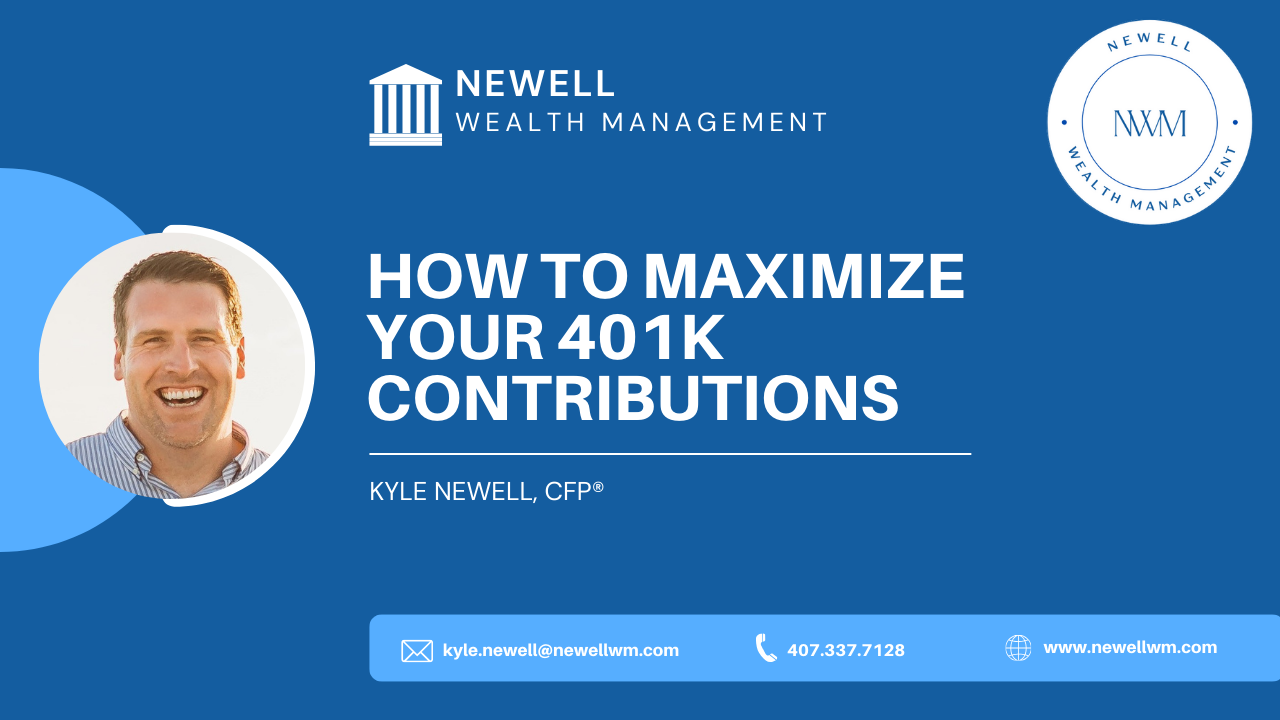How to Maximize Your 401k Contributions

If you have a 401k, you’ve probably wondered at some point, how to go about potentially maximizing your contributions. Here are three tips and strategies for you that may help.
1) Understanding the Limits
People often think the limit is a percentage tied to their match or just a percentage of their income. The limit is actually a dollar amount set by the IRS.
There is a lot of confusion around 401k limits, especially as you start to jump up the income ladder. Often, when you first start working for a company, you begin making some contributions. A great place to start is getting your company match.
For salaried workers at the Walt Disney Company, for example, Disney matches the first 4% of your 401k contributions. Disney matches 50% up to 4%. That means that if you put 4% of your salary into your 401k, Disney is going to give you 2%. That’s free money on 2%.
However, the match is not your maximum amount, nor is it really any percentage of your salary. Some companies will put a limitation on how much percentage you can put in. Some of my clients used to work for other companies, retired to Orlando, and are now working at the Walt Disney Company to fill their time.
They end up having a 401k and want to put all of their salary into it. Companies usually use the 50% mark as a limitation. Although a company may have a percentage limitation, the actual 401k contribution limits are set by the IRS.
The IRS breaks 401k contributions into two categories.
- Before 50: Lower amount
- After 50: Catch up amount
These amounts change every year, so one of the first things I do with clients is look at their income. Do they want to maximize their 401k contributions? We then make sure that we have the right percentage going in January and throughout the year.
If you’re just now getting started, you can see your 401k contributions in dollars. Your 401k contributions are set up as a percentage, which is then converted into a dollar amount that goes in every pay period.
Disney pays weekly so that means that Disney cast members will see a dollar amount each week for their 401k contributions. The dollar amount is based on the percentage they selected when they elected to participate in the Disney 401k benefit.
Based on the dollar amount you see per pay period, you can annualize the amount for the entire year to see if it’s the right amount or not.
Example
For 2024, the limitation is $23,000 if you’re under 50. If you’re over 50, it’s $23,000 plus the catch-up provision of $7,500, for a total of $30,500. The IRS may change the 401k contribution limitations for 2025, 2026, and beyond.
The point is that you want to be sure you understand the annual dollar amounts so that you can make the right 401k contribution elections with your paycheck.

2) Understanding the Tax Implications
It’s essential to understand the tax implications of your 401k contributions. Are you getting a tax break this year, or are you going to get a tax break down the road?
There’s one type of contribution where you’re able to get a tax rate this year as a taxable deduction.
Example
Let’s say you contributed the full amount and are under 50 ($23,000 a year). If you make $100,000 this year and contribute $23,000 to your traditional 401k contribution, you’ll be taxed on $77,000 of income, not the full $100,000.
The $23,000 will move forward, and though it’s never guaranteed, hopefully, it will grow with investing. If the $23,000 grows to $50,000 by the time you retire, the $50,000 will be taxable when you take it out in retirement.
Roth Contributions
There’s also a strategy called Roth contributions, named after Senator William Roth, who introduced the concept in the 90s. With a Roth contribution, you get no tax break this year for your contributions.
Using the same example as before, this means you would be taxed this year on the full $100,000 of income. If your $23,000 Roth contribution grows to $50,000 by retirement, the money is now tax-free when you take it out as long as you follow the rules associated with Roth contributions.
One primary rule, as of the date of this blog post, is that the money has to have been in the Roth for at least five years. If you’re using a Roth or plan to, ensure you are aware of the rules associated with it regarding taxes.
3) Having the Right Investment Strategy
Having the right investment strategy associated with your 401k contributions will significantly impact how those contributions will potentially grow over time. Of course, we want to be prudent with our decisions, not just putting money into a 401k. I often hear people say, “Well, I’m just gonna set it and forget it. I just picked whatever the highest earner was at that time.”
They put the money in there, and they haven’t looked at it again for 20 years. That is a strategy, but is it a good one? I don’t think so. Only time will tell because investments obviously aren’t guaranteed, and nobody can tell the future.
However, when it comes to investment selection within your 401k, you may have limited options. The Walt Disney Company’s 401k, for example, only has a certain number of investment options.
You have to decide how you want to allocate your contributions. Do you want all of your money to go into one fund or several funds? There are different types of investment funds. Some are more aggressive, and some are more conservative. They all have their own risks associated with them, depending on what the potential market environment would be.
It’s essential to evaluate your risk capacity and comfort level with risk and then turn that into investment decisions. Risk assessment is really one of the main ways of maximizing your 401k contributions. You want the money to hopefully earn money.
You invest because you hope to eventually live off that money as it grows and compounds over time. A person who is three years away from retirement needs a different investment strategy than somebody who’s maybe 30 years away from retirement.
401k’s are commonplace now. Still, there is a lot of confusion around them and how to maximize your 401k contributions. Remember these three tips and strategies:
- Understand the limits.
- Understand the tax implications.
- Have the right investment strategy.
Doing so could potentially help you get the best from your investments.
Important Information
Newell Wealth Management, LLC (“NWM”) is a registered investment advisor offering advisory services in the State of FL and in other jurisdictions where exempted. Registration does not imply a certain level of skill or training. The presence of this website on the Internet shall not be directly or indirectly interpreted as a solicitation of investment advisory services to persons of another jurisdiction unless otherwise permitted by statute. Follow-up or individualized responses to consumers in a particular state by NWM in the rendering of personalized investment advice for compensation shall not be made without our first complying with jurisdiction requirements or pursuant an applicable state exemption.
All written content on this site is for information purposes only and is not intended to provide specific advice or recommendations for any individual. Opinions expressed herein are solely those of NWM, unless otherwise specifically cited. Kyle Newell and NWM are neither an attorney nor an accountant, and no portion of this website content should be interpreted as legal, accounting or tax advice. Material presented is believed to be from reliable sources and no representations are made by our firm as to other parties’ informational accuracy or completeness. There is no assurance that the views or strategies discussed are suitable for all investors or will yield positive outcomes. Investment involves risks including possible loss of principal and unless otherwise stated, are not guaranteed. Any economic forecasts set forth may not develop as predicted and are subject to change. All information or ideas provided should be discussed in detail with an advisor, accountant or legal counsel prior to implementation.
